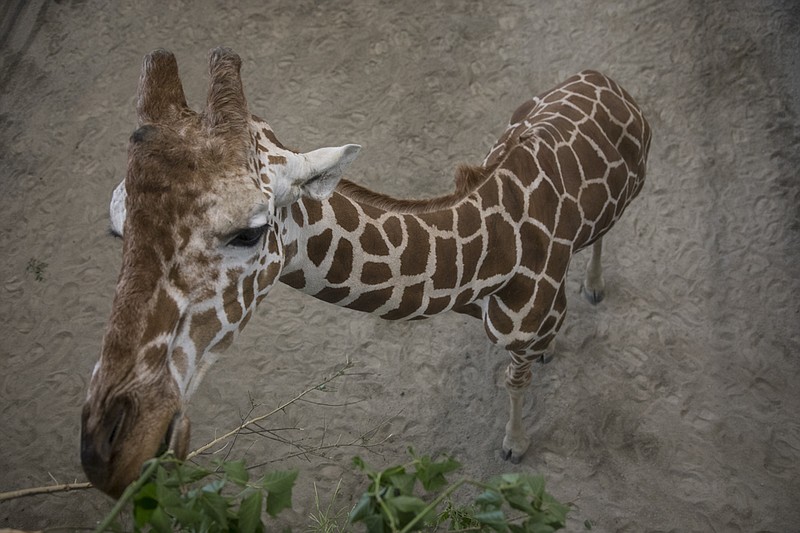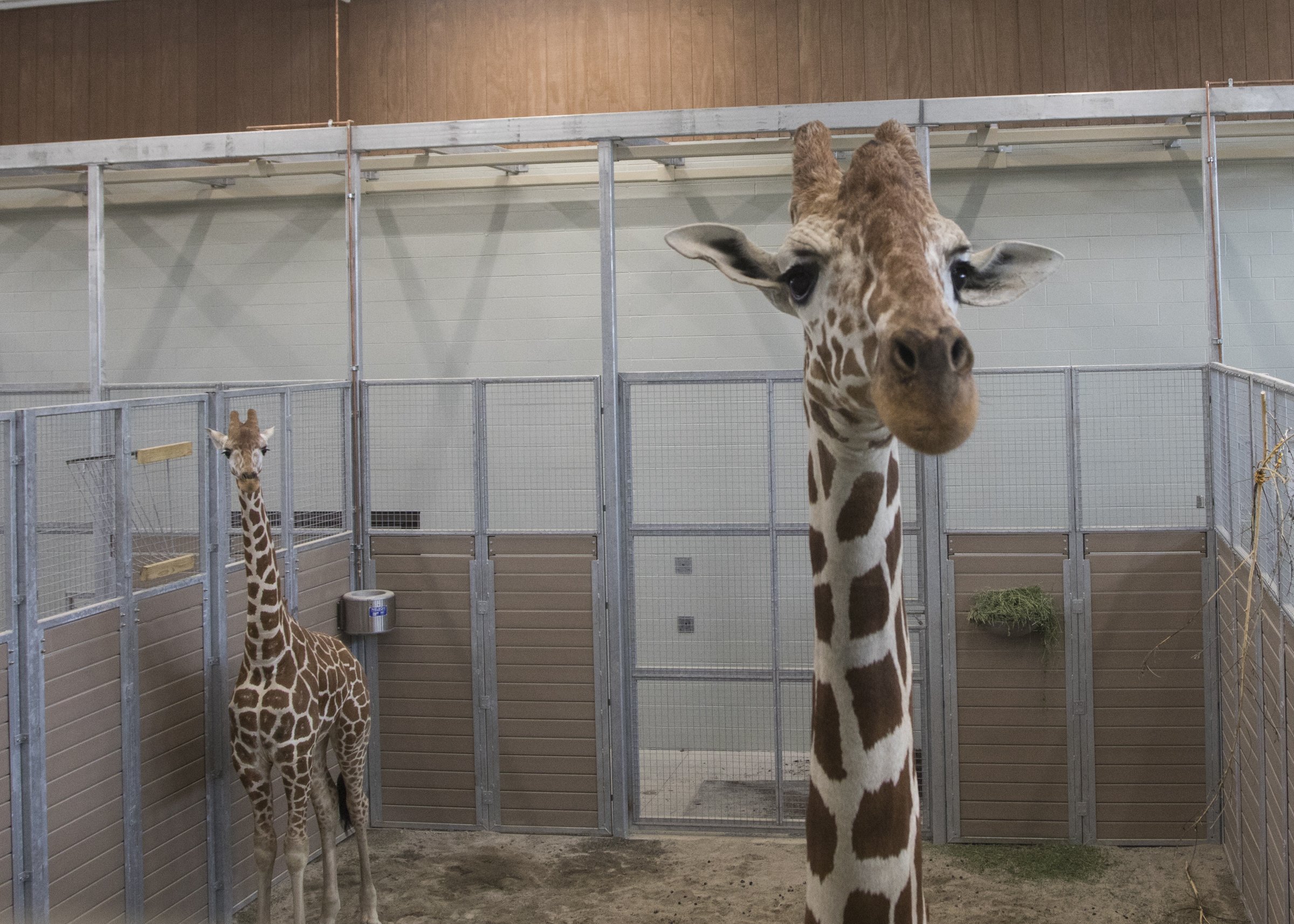You've probably heard by now that Chattanooga Zoo has added three male reticulated giraffes, but how much do you know about the new additions - and what does reticulated mean anyway?
The arrival of George, Porter and Hardee Star culminates a years-long, $2.5 million capital campaign the zoo dubbed "Reaching Great Heights." This checks off Phase 1 of that master plan.
Phase 2 could add "hoof stock like gazelles and really cool things like warthogs," says CEO and President Dardenelle Long.
Later phases would add more animals the zoo doesn't have, as well as a covered pavilion for event rentals, instead of the current tent. It's also possible another existing exhibit will have to be enlarged "if the meerkats keep having babies," Long says, only half-joking.
To get you better acquainted with the new giraffes, we've answered a few questions you might have been wondering.
* Where did they come from?
The three bulls were living together as a herd at the Freeport-McMoRan Audubon Species Survival Center in New Orleans, a facility that has worked since 1993 to boost dwindling populations of disappearing animal species. The giraffes' neighbors there included whooping cranes, Mississippi sandhill cranes, several species of endangered storks, clouded leopards, Mexican grey wolves, red wolves, bongo antelope and eland.
* How did they get here?
They arrived by a special transport carrier, Wildlife Transportation Facilitators, based in Stevensville, Maryland. Owner/operator Callan Hahn says he has transported "several hundred [animals] a year for several years" after growing up at a zoo his father bought in 1966, the Catoctin Wildlife Preserve and Zoo. "We don't transport elephants and cetaceans (whales)," he says, "but we do transport sea lions and walrus."
* How exactly do you transport a giraffe cross-country?
Hahn says his equipment is "specifically built to meet any needs of the animals we transport. For example, we have a hydraulic roof on one of the trailers that goes up higher [from 13 feet to 19 feet, 6 inches]."
Before each trip, zoo behavior teams analyze the circumstances and how to best meet the animals' needs during transport.
"Traffic situations play a part; stop-and-go traffic is not good for giraffes," Hahn says. "They are also temperature-sensitive. We are climate-controlled, so that works really well transporting giraffes. Generally, they do travel well."
Hahn says his favorite story from the road involved a giraffe that "would stick his tongue out at every car or truck going by. If you can visualize, that's an 18- to 20-inch tongue coming out at you that looks like one of those party favors."
* Did they all fit in one trailer?
Hahn's team made two back-to-back round trips between New Orleans and Chattanooga. George, the eldest, came first, arriving Wednesday, May 20. Porter and Hardee Star arrived Friday, May 22. Zoo officials gave them a few days to settle in before announcing their arrival on Tuesday, May 26.
* How are they doing?
Zoo officials say the giraffes are still settling in and getting used to their new surroundings.
Long says their interactions have been fun to watch. Hardee Star typically follows the lead of his older companions, but last week he was brave enough to want to stretch his legs outside the barn. But only for a minute.
"The big guy [George] was standing in the doorway," Long recounts, "and the little guy came up beside him in this tall, narrow hallway. It was only a few steps to be outside. He took a couple, three steps and slipped right by [George]. Then he looked around and was like, 'Oh wait' and went back into the barn."
* Who's taking care of the giraffes?
Long says two full-time and one part-time keeper have been hired. The full-timers are from the Milwaukee County Zoo in Wisconsin and Zoo Boise in Idaho.
* Where are giraffes native to?
Reticulated giraffes are a subspecies of giraffe native to the Horn of Africa. They have a relatively limited range across northern and northeastern Kenya, with small populations in the southern regions of Somalia and Ethiopia.
* Are they endangered?
According to the International Union for Conservation of Nature, there are only 15,780 reticulated giraffes estimated to remain in the wild and are listed as an endangered species by the IUCN Red List. Reticulated giraffes are threatened by habitat deconstruction and poaching.
* What does reticulated mean?
"Reticulated" refers to the geometric patterns that identify the breed - a network of clearly defined, fine white lines on the giraffes' chestnut-colored coat. Coat color and spot patterns vary among the nine giraffe species.
* Will the zoo host a big event to celebrate the giraffes' arrival?
Yes, but not until later in the year because of the coronavirus. But you can visit anytime - the zoo is open 9 a.m.-5 p.m. daily - for a glimpse of them in their barn or yard. The new exhibit is called Makazi Ya Twiga, but don't be too put off by the exotic-sounding Swahili name. It translates to "Giraffe Habitat."
Email Lisa Denton at ldenton@timesfreepress.com.
MEET THE GIRAFFES
GEORGE* Age: 5 1/2.* Birthday: Aug. 26, 2014.* Good to know: According to his keepers, George is one of the most easygoing giraffes you’ll ever meet. He’s very gentle, very calm and will do anything for his favorite tree leaves. American elm is his favorite. George was born at a zoo in California, and his caretakers joke that that’s where his laid-back attitude comes from.* Bonus: George was born as a twin, which is very rare in giraffes, so he is not a very tall male in giraffe terms, but he doesn’t seem to mind.PORTER* Age: 3.* Birthday: Feb. 13, 2017.* Good to know: Porter was born on Mardis Gras, always a day of celebration in his original home of New Orleans. Keepers say his exciting birthday fits him perfectly as he is very curious, loves to be the center of attention and has a kingly attitude.HARDEE STAR* Age: 17 months.* Birthday: Dec. 2, 2018.* Good to know: As the youngest of the herd, Hardee Star has a very different personality from George and Porter. He’s shy and skeptical of any changes in his surroundings. Hardee Star looks up to his herd mates for security and safety and won’t be found by himself very often. Although none of the giraffes is related to the others, Porter and Hardee Star have grown up together as brothers.


